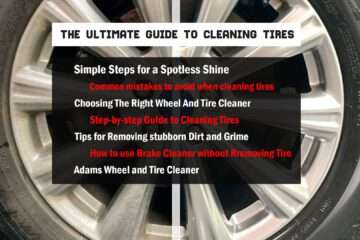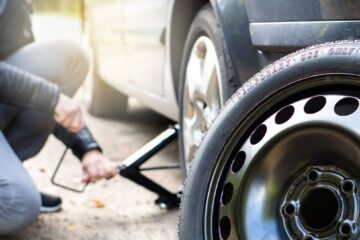When it comes to choosing the right tires for your vehicle, one crucial factor to consider is the Tire Speed Ratings. The alphanumeric markings on your tire sidewall offer crucial insights into the tire’s speed capabilities and restrictions. Understanding tire speed ratings is essential for safe and optimal performance on the road. In this blog post, we will decode tire speed ratings, discuss what the numbers and letters mean, and provide helpful tips for selecting the right tires for your driving needs. Stay tuned to gain a better understanding of tire speed ratings and make informed choices for your vehicle.
1. What Is Tire Speed Ratings?
When shopping for tires, you may have come across a combination of numbers and letters on the sidewall of the tire. These markings are not just random codes; they convey important information about the tire’s performance capabilities, specifically its speed rating. Let’s delve into what tire speed ratings are, what the numbers and letters mean, and how they can impact your driving experience.
What Are Speed Ratings on Tires?

Tire speed ratings indicate the maximum speed capability of a tire under ideal conditions. These markings are especially important for high-performance vehicles, ensuring that the tire’s capabilities align perfectly with the vehicle’s speed potential. The speed rating is represented by a letter from A to Z, indicates the maximum speed a tire can safely maintain over time while supporting its maximum load. This system was developed to standardize the performance of tires at high speeds in a controlled environment.
With the higher ratios of the speed rating, You’ll get the better control at higher speeds. These ratings were developed to ensure safe tire performance at standardized speeds.
Decoding the Speed Rating
The speed rating is typically found at the end of the tire’s size code on the sidewall. For example, a tire marked as P225/60R16 97V has a speed rating of ‘V.’ This means the tire can withstand sustained speeds of up to 149 miles per hour.
The Importance of Adhering to Speed Ratings
Speed ratings are not suggestions for driving speeds but reflect the tire’s ability to dissipate heat generated at high speeds. Exceeding the speed rating can lead to reduced tire life and, more critically, tire failure, which could result in accidents.
Understanding the numbers and letters on your vehicle’s tires
Having highlighted the significance of tire speed ratings, let’s now explore a deeper understanding of the alphanumeric markings imprinted on your tire sidewall. The combination of letters and numbers signifies the tire’s speed rating, indicating the maximum speed capability the tire can handle. For instance, a tire with a speed rating of “V” can sustain speeds of up to 149 mph. Ensuring safety and optimal performance requires aligning your tire’s speed rating with your driving habits and vehicle specifications. In the following sections, we will break down the different speed ratings and their implications, guiding you towards making informed decisions for your vehicle’s tires. Stay tuned for valuable insights!
2. The Alphabet Soup: Decoding Speed Ratings
Tire speed ratings are denoted by letters from A to Z, covering a range from 5 km/h (3 mph) to above 300 km/h (186 mph). Every letter denotes a particular maximum speed that the tire is certified for. Yet, it’s important to remember that the speed rating alone doesn’t encompass the tire’s overall performance capabilities.
Here’s a glimpse of the speed rating chart:
- L – 75 mph: Off-Road & Light Truck Tires
- T – 118 mph: Family Sedans & Vans
- H – 130 mph: Sport Sedans & Coupes
- V – 149 mph: Sport Sedans, Coupes & Sports Cars
- W: Handles speeds up to 168 mph.
- Y: Designed for 186 mph: High-End Sports Cars
- ZR: Reserved for tires with maximum speed capabilities beyond 149 mph (e.g., P275/40ZR17 93W).
- ZR (Higher Speeds): For tires capable of speeds exceeding 186 mph (e.g., P275/40ZR17 93Y).
3. Where to Find Your Vehicle’s Tire Speed Rating
You can locate your tire speed rating in several places:
- Owner’s Manual
- Driver’s Side Doorjamb
- Glove Box Door
- Gas Tank Hatch
Recent standardization includes incorporating the speed symbol and load index as part of every tire’s service description on the sidewall. When checking your tire sidewall, locate the speed rating as the final item in the character sequence within the tire’s size code. For example:
- 205/60R15 91V: Here, the tire has a speed rating of V, allowing speeds up to 149 mph.
Tire Speed Rating Chart:

Here’s a breakdown of common speed ratings and their corresponding speed limits in miles per hour (mph):
- Q (99 mph): Typically found on compact cars and sedans, suitable for everyday driving conditions.
- S (112 mph): Commonly used on family sedans and minivans, providing a good balance of performance and comfort.
- T (118 mph): Found on a wide range of vehicles, including SUVs and trucks, offering enhanced performance capabilities.
- U (124 mph): Uncommon in North America, this rating corresponds to speeds up to 124 mph.
- H (130 mph): Often seen on sporty sedans and coupes, delivering high-speed performance and handling.
- V (149 mph): Found on high-performance cars, ensuring excellent stability and control at high speeds.
- W (168 mph): Designed for ultra-high-performance vehicles, offering exceptional handling and grip at extreme speeds.
- Y (186 mph): Found on supercars and sports cars, providing the highest level of speed capability and performance.
- Z (149+ mph): An additional symbol used for tires capable of speeds over 149 mph.
You May Also Check
Discover how long does it take to charge electric car?
how long does it take to charge electric car? Electric cars have become increasingly popular in recent years as environmentally […]
How tire speed ratings impact your driving experience
Your tire’s speed rating plays a vital role in your driving experience. Choosing the right speed rating ensures optimal performance and safety on the road. It directly influences your vehicle’s handling, stability, and braking capabilities, especially when driving at higher speeds. Overlooking the recommended speed rating can lead to compromised safety and reduced tire longevity. In the following sections, we’ll delve into the importance of aligning your tire’s speed rating with your driving habits and your vehicle’s capabilities. Stay informed to make well-informed decisions when selecting tires for your vehicle. Your safety and driving experience depend on it.
4. What Is a Good Speed Rating for Tires?
The appropriate speed rating for your tires depends on your vehicle type, driving habits, and local speed limits. For most passenger cars and everyday driving scenarios, a speed rating of S or T is sufficient. These ratings guarantee a safe and dependable performance in standard driving conditions while maintaining comfort.
However, if you drive a high-performance vehicle or frequently travel at high speeds, opting for a higher speed rating such as H, V, W, or Y can enhance handling, stability, and overall performance. It’s important to match your tire’s speed rating with your vehicle’s capabilities to maintain safety and optimize performance.
The ideal speed rating depends on your driving habits and vehicle type:
- S and T: Common ratings for sedans, minivans, and light trucks.
- H: Suitable for some passenger cars, sports cars, and coupes.
- N, P, Q, and R: Found on light trucks.
- V, W, and Y: For high performance and for some electric vehicles.
Keep in mind, the speed rating is not a suggestion to surpass speed limits but indicates the tire’s maximum safe speed when inflated correctly.
5. Speed Tire Rating Comparison

Let’s compare two common speed ratings, H and V, to understand their differences:
- H (130 mph): Suitable for sporty sedans and coupes, offering good performance and handling at high speeds.
- V (149 mph): Ideal for high-performance cars, providing superior stability and control at extreme speeds.
Choosing between H and V ratings depends on your driving style and the requirements of your car. If you prioritize performance and often drive at higher speeds, a V-rated tire may be more suitable. However, for everyday driving with occasional bursts of speed, an H-rated tire can deliver adequate performance without exceeding typical speed limits.
Winter Tire Speed Ratings
Winter tire speed ratings are specifically designed to indicate the maximum safe speed that winter tires can handle while providing optimal performance in snowy and icy conditions. Unlike all-season or summer tires, winter tires are constructed with a softer rubber compound and unique tread patterns that are optimized for traction on snow and ice.
Here’s what you need to know about winter tire speed ratings:
- Q-Rated Tires: These are the most common winter tire speed ratings, indicating a maximum safe speed of up to 99 mph. They are suitable for most passenger vehicles and provide good performance in winter conditions.
- Higher Speed Ratings: Some winter tires come with higher speed ratings like H (up to 130 mph) or even V (up to 149 mph), which may be required for high-performance vehicles. However, it’s important to note that while these tires can handle higher speeds, they may not perform as well in deep snow compared to Q-rated tires.
- Vehicle Compatibility: Always check your vehicle’s owner’s manual or the driver’s side door latch for the recommended speed rating for winter tires. It’s crucial to match the tire’s speed rating with your vehicle’s requirements to ensure safety and optimal performance.
- Performance Considerations: Mixing different speed-rated tires on your vehicle can lead to inconsistent performance and handling. Ensure all your winter tires have the same speed rating and are suitable for your vehicle’s specifications.
The primary goal of winter tires is to provide safety and control in cold weather conditions, not to facilitate high-speed driving. Always prioritize traction and stability over speed when choosing winter tires for your vehicle. Drive safely and adjust your speed according to the road conditions, regardless of your tire’s speed rating.
Choosing the right tire speed rating for your vehicle
Selecting the appropriate tire speed rating is crucial for ensuring optimal performance and safety on the road. When selecting the appropriate speed rating for your vehicle, take into account factors like your driving habits, average driving speeds, and the recommendations from the manufacturer. Aligning the speed rating with your vehicle’s capabilities can improve handling, stability, and the overall driving experience. Remember that a higher speed rating may provide better performance but may not always be necessary for everyday driving. By understanding the significance of tire speed ratings and making informed decisions, you can prioritize safety and longevity for your vehicle’s tires. Stay tuned for practical tips on how to assess and choose the ideal speed rating for your car.
You may also check
Unveiling the Superior Performance of Hankook Tires: A Comprehensive Review
Hankook Tires, a renowned global leader in the automotive industry, has been crafting premium-quality tires that deliver unparalleled performance, safety, […]
Safety considerations when it comes to tire speed ratings
When choosing tire speed ratings, prioritize safety above all else. Opting for a speed rating that aligns with your vehicle’s capabilities and typical driving conditions is crucial for ensuring optimal performance and safety on the road. Exceeding the recommended speed rating can lead to decreased traction, poor handling, and increased risk of accidents. When selecting the right tire for your car, prioritize safety over perceived performance advantages. Stay informed and make educated decisions to enhance your driving experience while keeping safety at the forefront. Watch out for practical guidelines on how to prioritize safety when considering tire speed ratings in the upcoming blog section.
You may also check
Focused on Tire Pressure Monitoring Systems (TPMS)
Introduction: Tire Pressure Monitoring Systems (TPMS) have evolved into essential safety components in contemporary vehicles. These systems play a critical…
Consulting with a professional for guidance on tire speed ratings

Consulting with a professional for guidance on tire speed ratings is a wise decision to make. A trained technician or tire specialist can offer valuable insights based on your specific driving habits, vehicle specifications, and local road conditions. They can help you interpret the numbers and letters on your car tires to determine the most suitable speed rating for optimal performance and safety. Their expertise can ensure that you make an informed choice that aligns with industry standards and manufacturer recommendations. Don’t hesitate to seek professional advice to make the best decision for your vehicle’s tires and your overall driving experience. Stay tuned for more expert advice on navigating tire speed ratings effectively.
Concluding thoughts on the significance of understanding tire speed ratings in ensuring road safety
Concluding thoughts on the significance of understanding tire speed ratings in ensuring road safety are paramount. Adequate knowledge of these ratings not only enhances performance but also plays a crucial role in maintaining safety on the road. By deciphering the numbers and letters on your car tires, you are taking a proactive step towards optimizing your driving experience and safeguarding yourself and others. It’s essential to prioritize safety by choosing the appropriate speed rating recommended for your vehicle to prevent potential risks associated with mismatched tires. Stay informed and stay safe on the roads by valuing the importance of understanding tire speed ratings. Stay tuned for more insightful tips on maximizing your driving experience.
Conclusion – Tire Speed Ratings
Tire speed ratings are a critical factor in ensuring your vehicle’s safety and performance. By understanding and adhering to these ratings, you can make informed decisions when purchasing new tires and enjoy a safe driving experience.
Remember, the speed rating is about safety, not performance. It ensures that your tires can handle the heat and stress at high speeds, keeping you safe on the road.
I hope this article provides a clear understanding of tire speed ratings and their significance in vehicle safety and performance. Remember to check your tire speed rating and adhere to it for a safe driving experience.




